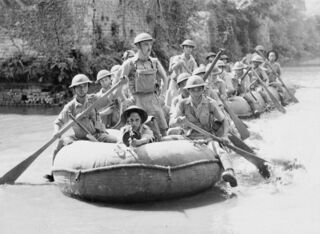Taoyuanese Civil War
| Taoyuanese Civil War | |||||||
|---|---|---|---|---|---|---|---|
 Taoyuanese Forces in the Fuinan River | |||||||
| |||||||
| Belligerents | |||||||
|
|
File:Free Territory of Freedomland Flag.svg Bactieu and the Adelaidines | ||||||
| Commanders and leaders | |||||||
|
|
| ||||||
| Strength | |||||||
|
July: 150,000 October: 355,000 |
July: 350,500 October: 230,000 | ||||||
The Taoyuanese Civil War was fought between the Taoyuanese Rebels with Commonwealth backing against Quenmin. The war was caused by two pre-war events, the Taoyuanese Independence Protests of 1947 and the Chiayi Shootings of 1947. In July 1947, Taoyuanese General Soong Feng-jeou led an uprising in Kaohsong and the news soon spread all over Taoyuan. The Quenminese, still recovering from the war damages caused by the Second Europan War, had difficulty in containing the rebellion as the Taoyuanese locals had mostly aligned themselves with the Soong and the rebellion. The war ended in October 19, 1947; under pressure from the international community towards Quenmin to grant Taoyuan its independence. Majority of historians remarked the rebellion as the complete end to the Quenminese Empire.
The war gave Taoyuan its international recognition and status, becoming one of Asianna's most industrialized and modernized countries.
Background
The War
Combatants: Taoyuan
Combatants: Quenmin
Aftermath
Domestic Reaction
Quenmin
After the Miracle at Medan occurred, anti-war dissent among the public grew increasingly resonant.
Few days later after the Battle of Laonong, the Ground Force Protest of 1947 occurred, with the Heavy Cavalry Regiment and several other units like the 252nd Infantry Division voicing their refusal to serve, even the future War of Lorican Aggression general Sử Công Nguyên.